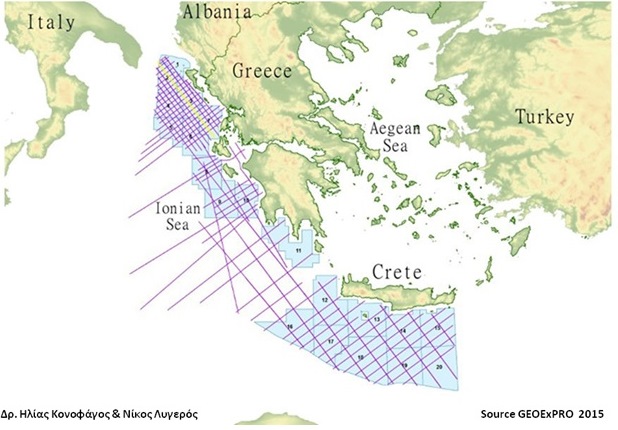20479 - The enhancement of subsea hydrocarbon fields South of Crete demands New Strategy
E. Conophagos, N. Lygeros
Translated from the Greek by Vicky Baklessi
Since 2012, we the undersigned had introduced to the highest possible political level, for the Greek state to invite to tender a large number of sea blocks in the Ionian sea and South of Crete. Our objective was always – in the midst of the economic crisis – the development of mineral wealth for relieving the economy and the unemployment of the new generations. And we had at the same time emphasized the need for a specific national high strategy to exist in order to meet the above foundational issue for our homeland.
Three years later we establish that the effort that was put in didn’t bear the fruit which we expected, since only 3 (three) tenders were submitted to the authorized ministry for a total of 20 (twenty) sea blocks. It suffices to recall that Cyprus in 2012 had 15 tenders by consortiums in a total of 12 (twelve) sea blocks. What is most significant in this case is that South of Crete (which scientifically and technically is considered a part of the geological section of Southern Ionian, see Pic.1) there were no tenders submitted, and this was even though this area could comprise ten times more hydrocarbons’ reserves from the relevant expected reserves of mid and northern Ionian together.
In our opinion the results of the Greek round of concessions are on one hand due to the difficult economic and political situation which doesn’t provide safety to those who want to invest in Greece, but also of course to the lack of professional strategy which must be corrected for the next rounds of licensing so that we achieve finally effective and robust results. On this issue we would like to clarify the following data:
• Due to the vast sea area which was granted recently by the Greek state for seismic research, we had in the recent past introduced that the Public Bid for the Seismic Research in the Ionian Sea and South of Crete (area of 22.000 km2) be awarded – from a strategic perspective – to two separate contractors (from the 8 tenders that existed) and not only to one sole contractor (PGS). PGS due to the high cost of works it assumed in such a large area provided a very rich plan in the Ionian and an extremely poor plan for South of Crete. It is obvious that the existence* of two contractors, one in Northern Ionian and one in South of Crete would had allowed us to have today, as it was in Cyprus, the same richness in research data for both of the above mentioned research areas. The availability of more research data from South of Crete would have allowed better identification of the research- per block-investment risk, so that the contractors could submit tenders with greater investment safety.
• In order to be greater investor attendance in our country we had also introduced in the past that the blocks do not be uniform in geometry and area but to be dependant– as it is everywhere in the world- on the sea depth and the size of the available scientific data per block. It is obvious that the size of the blocks’ area in South of Crete should be much larger than the respective size of the blocks in the Northern Ionian due to the lack of seismic data relevant to the Ionian.
• Because most of the blocks in South of Crete are in high seas and in presence of the Tobruk base across Crete, the invitation to tender should have suggested in an intelligent manner the state’s minister for the security of the highly expensive equipment of subsea research works of the investors from possible terrorist actions, sabotage or piracy actions. We should note the absence of the Port Authorities and of the Armed forces from the committees in the preparation of the tenders and the receipt of contractors’ tenders.
• Finally to emphasize towards every direction that we are trying to pass the message to the state that it could attract investors not only for the extraction of hydrocarbons, but also for the development of new technology on behalf of the state, which could remain to benefit our children and our homeland. This proposition requires also tax incentives (e.g. 5-year period of zero taxation) and relates much to conventional hydrocarbons in great depths as well as to non conventional hydrocarbons (methane hydrates). We should also mention that Greece has the largest subsea reserves of methane hydrates in the European Mediterranean.
Concluding we should remind that our proposition for the development of a strategy for the enhancement of the subsea fields in the EEZ of our homeland (and not only the enhancement of hydrocarbon imports) is today’s only reliable proposition on growth for developing local mineral wealth towards relief of the economy of our homeland and of course for developing a large number of employment positions.


